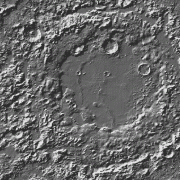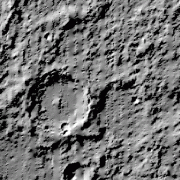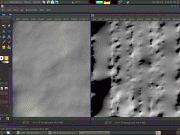John,
Nothing is 32bit except the GRDs.
Jim,
QUOTE (Jim Mosher @ Mar 18 2010, 01:56 PM)

I don't think there are any major problems with the most recent *.LBL files, but I wonder if it would be possible to upload copies of "LDEM_4.LBL" and "LDEM_16.LBL" with the "OFFSET" parameter in "OBJECT = IMAGE" corrected to "1737400." <meters>? The text description implies this is the offset used for forming the signed integers, but it is correctly listed on the machine-readable "OFFSET" line only in "LDEM_64.LBL". The other two *.LBL files, as John points out, give "1728216.", a number which may never have been correct.
This seems sensible. I will double-check tomorrow and correct it.
We are working on improving the labels in general. Very soon you'll have one label file per product format (jp2,img,grd).
Bottom line, I think LDEM_64.LBL is correct.
QUOTE (Jim Mosher @ Mar 18 2010, 01:56 PM)

This may seem a very insignificant point -- since users can easily hand-edit these text files -- but I was writing directions on how to use the LOLA data with
a program that automatically reads the *.LBL files associated with the *.IMG files, and this seems to add an unnecessary level of complication and confusion.
Good to see people integrating the data in their program already

On that website you say "Nonetheless, LOLA gridded data covering the period 2009-07-13 through 2009-12-17 are (unofficially?) available on an MIT website." Actually, this MIT website is the official LOLA PDS
data node. PDS archives/mirrors it.
QUOTE (Jim Mosher @ Mar 18 2010, 01:56 PM)

Since obtaining altimeter data by satellite at a particular geographic point seems largely a matter of luck, I was wondering, as many must be, if anyone on the LOLA team has attempted integrating the raw data from Kaguya with the new data from LRO to produce a more complete and denser data set from which a more comprehensive gridded product might be produced?
Emily is perfectly correct in her post. We don't want to take the Kaguya data at face value (even though they've done a good job) and simply put them in. The LOLA data are geolocated based on LRO orbit solutions, which we understand and are working on improving... And with time, we'll cover (very close) to those Kaguya tracks.
QUOTE (Jim Mosher @ Mar 18 2010, 01:56 PM)

One other very minor point: the *.LBL files say your grid is reported in the "MEAN EARTH/POLAR AXIS OF DE421" coordinate system. To the best of my knowledge, the Moon's Mean Earth/Polar Axis system is offset from the JPL DE421 ephemeris system by small rotations about each axis. Did you apply those corrections? If so, did you use the rotations recommended in the "IAU/IAG Working Group on Cartographic Coordinates" reports of
Seidelmann et al. or some other ones?
I think all your answers will be found in :
ftp://naif.jpl.nasa.gov/pub/naif/generic_...orientation.pdfIf you're familiar with SPICE, basically, in addition to using the "de421.bsp" kernel, we also load the following kernels, which define the "MOON_ME" frame.
moon_pa_de421_1900-2050.bpc, moon_080317.tf, moon_assoc_me.tf, also available from the NAIF website.
QUOTE (Jim Mosher @ Mar 18 2010, 01:56 PM)

Finally, although I find nothing materially wrong with the *.LBL files, I find the references to "planetopotential TOPOGRAPHY" and "GEOID" in the explanation of the data format slightly confusing. As I understand the explanation, the data represent "PLANETARY_RADIUS" rather than "planetopotential TOPOGRAPHY", and since no geoid is defined, and no correction for it required to use the data, the references to this additional computation seem unnecessary?
well, you can see that as superficial; but it's just recalling what is in this dataset, so that people know it's not geoid-related ("huge discovery: lava flows going uphill!"). We may release planetopotential topography grids in the future. Plus, in the RDRs, the geoid value at each LOLA point is defined.
Erwan








